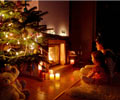The European holiday traditions that predate – and became an inseparable part of – Christmas have been explored.

‘Holiday beverages like eggnog, mulled wine and hot cider often include cinnamon, cloves and/or other spices. They were a sign of wealth, so bringing them out for celebration was equivalent to bringing out the best wine for guests.’





What is the origin of Christmas caroling? The act of going from house to house during the darkest time of the year to spread hope through song has its origins throughout Europe and takes many forms including the British tradition of Wassail and Mumming, and the Slavic tradition of Koliada, which began before 998 B.C. In many traditions, people would go door to door and ask for permission to perform. They would recite poetry, sing and sometimes perform a skit. The idea was that these acts would bring about good fortune to influence a future harvest. Many of these visiting rituals were incorporated in the celebration of Christmas and are still performed in modern Ukraine as well as throughout Europe and across the United States.
Why do we associate Christmas with eggnog?
In medieval England, these spices were of high value and would have been traded for other goods. Drinks with eggs and cream may seem strange to palates today, but these were also common in Medieval England.
The ancestor of these drinks is wassail, named after the Anglo-Saxon phrase “waes hael” or “good health.” Wassail was originally made with mulled ale, curdled cream, roasted apples, eggs, cloves, ginger, nutmeg and sugar. It was served in huge bowls made of wood, pewter, porcelain, and silver. The act of wassailing would begin on the 12th day of Christmas – Jan. 5 or Jan. 6 – and included bonfires in the orchards, shooting guns to scare away bad spirits, caroling and pouring hot cider into the roots of trees for a good harvest the following year.
Advertisement
Mistletoe, an evergreen shrub, was used in celebrations dating back to the ancient Druids – Celtic religious leaders – some 2,000 years ago. Mistletoe represented immortality because it continued to grow in the darkest time of the year and bore white berries when everything else had died. Hanging its sprigs over doorways and windows was supposed to keep the evil spirits of disease from entering a house. Farmers found it easiest to remove parasitic mistletoe from apple trees in winter when the branches were barren.
Advertisement
Why is Christmas celebrated in December?
The winter solstice on Dec. 21 or 22 is the longest night of the year, but marks the return of the sun when the days will get longer. It’s considered a time of hope.
In pre-industrial Europe, you would have harvested all of your crops and then had three to six months of cold and dark, without the ability to grow food. Many people would slaughter some of their livestock because they would not be able to feed them through the winter, so this is when feasts would happen.
Neither the Bible nor history give a date for Jesus’ birth, though it was more likely closer to spring. But, because the solstice was already such a celebrated time of year in pre-Christian traditions, Christians came to use it to celebrate the birth of Jesus.
Source-Newswise













